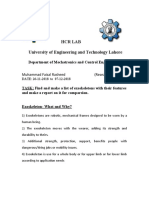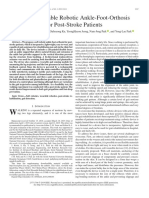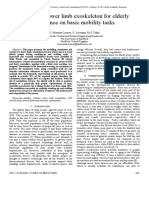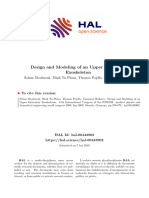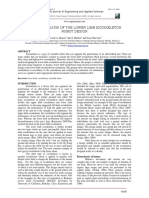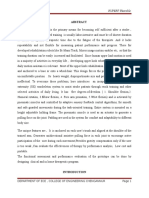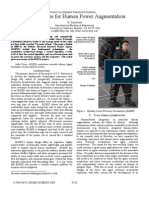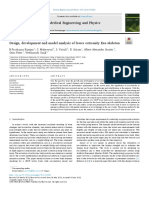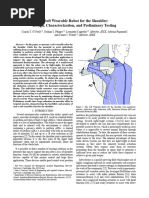0 ratings0% found this document useful (0 votes)
25 viewsExo of Many Trades, and Masters All.: International Conference On Robotics and Automation, 2011, Pp. 2178-2183
Exo of Many Trades, and Masters All.: International Conference On Robotics and Automation, 2011, Pp. 2178-2183
Uploaded by
Mark DanielNASA and IHMC are developing a powered lower extremity exoskeleton for applications including mobility assistance, rehabilitation, and exercise. The exoskeleton features torque controllable actuators at the hip and knee and passive joints at the hip. It is designed to accommodate different body sizes and anticipated uses include assisting with walking, loads, stairs, and resistive exercise.
Copyright:
© All Rights Reserved
Available Formats
Download as PDF, TXT or read online from Scribd
Exo of Many Trades, and Masters All.: International Conference On Robotics and Automation, 2011, Pp. 2178-2183
Exo of Many Trades, and Masters All.: International Conference On Robotics and Automation, 2011, Pp. 2178-2183
Uploaded by
Mark Daniel0 ratings0% found this document useful (0 votes)
25 views2 pagesNASA and IHMC are developing a powered lower extremity exoskeleton for applications including mobility assistance, rehabilitation, and exercise. The exoskeleton features torque controllable actuators at the hip and knee and passive joints at the hip. It is designed to accommodate different body sizes and anticipated uses include assisting with walking, loads, stairs, and resistive exercise.
Original Title
Neuhaus
Copyright
© © All Rights Reserved
Available Formats
PDF, TXT or read online from Scribd
Share this document
Did you find this document useful?
Is this content inappropriate?
NASA and IHMC are developing a powered lower extremity exoskeleton for applications including mobility assistance, rehabilitation, and exercise. The exoskeleton features torque controllable actuators at the hip and knee and passive joints at the hip. It is designed to accommodate different body sizes and anticipated uses include assisting with walking, loads, stairs, and resistive exercise.
Copyright:
© All Rights Reserved
Available Formats
Download as PDF, TXT or read online from Scribd
Download as pdf or txt
0 ratings0% found this document useful (0 votes)
25 views2 pagesExo of Many Trades, and Masters All.: International Conference On Robotics and Automation, 2011, Pp. 2178-2183
Exo of Many Trades, and Masters All.: International Conference On Robotics and Automation, 2011, Pp. 2178-2183
Uploaded by
Mark DanielNASA and IHMC are developing a powered lower extremity exoskeleton for applications including mobility assistance, rehabilitation, and exercise. The exoskeleton features torque controllable actuators at the hip and knee and passive joints at the hip. It is designed to accommodate different body sizes and anticipated uses include assisting with walking, loads, stairs, and resistive exercise.
Copyright:
© All Rights Reserved
Available Formats
Download as PDF, TXT or read online from Scribd
Download as pdf or txt
You are on page 1of 2
Exo of Many Trades, and Masters All.
Peter D Neuhaus1, Jerryll H. Noorden1, Roger Rovekamp2, Nick R Payton1, Travis J Craig1
1
Institute for Human and Machine Cognition, 2NASA Johnson Space Center
Preferred Format: Poster.
1. Introduction thigh, just below the gluteal fold. An adjustable strap
NASA Johnson Space Center and IHMC are jointly will secure the user’s limb to the cuff structure. The
developing a powered lower extremity exoskeleton. type of cuff suitable for exercise applications has not
The focus of this collaboration is to develop a robotic yet been determined, and will be explored once the
device for a range of applications, including mobility device is functional.
assistance for abled and disabled users, rehabilitation,
and exercise. The robot features torque controllable The hip ab/adduction joint will feature free rotating
actuators at the hip flexion/extension and knee bearings with a gravity counter balancing elastic
flexion/extension and passive joints to allow for hip element. This elastic element will be preloaded to
ab/adduction and hip internal/external rotation. The produce an abduction torque to assist the user during
powered joints will be capable of variable stance and swing. The hip internal/external rotation
impedance, ranging from zero impedance for joint will initially be only a free bearing and no
transparent mode to high impedance for stiff position passive components.
control. The links of the exoskeleton can be adjusted
to the user’s body size such that the powered joints For mobility assistance (for users with paraplegia and
are co-located with the user’s joint, creating an paresis), the passive nature of these joints will have
anthropomorphic structure. to be significantly altered. IHMC’s previous
exoskeleton, Mina v0 [2], has the hip ab/adduction
2. Description of Hardware degrees of freedom rigidly constrained. The free
The targeted uses for the NASA-IHMC Exoskeleton bearings of the NASA-IHMC Exoskeleton at these
include mobility assistance for abled and disabled joints allow us to explore the effect of adding various
users, rehabilitation, and exercise. The common levels of passive compliance with the intent of
feature in all of these activities is a robotic device increasing mobility.
that is worn over the lower extremities and exerts
forces and torques in a controlled manner. In The NASA-IHMC Exoskeleton weighs
operation, the device must assist (or resist in the case approximately 53 pounds, and is tethered for power.
of exercise) when able and not impede when unable. Adding batteries will be considered at a later stage of
The key component of the device is the series elastic research. The Mina v0 prototype consumed 100W
actuator at each powered joint. Building on each while walking over level ground, which translates to
organization’s years of experience, we have designed approximately 1 kg of battery per hour of walking
a high-fidelity force controllable actuator capable of operation.
torques on par with what a healthy adult can produce
and enough speed for a moderate walking pace. As 3. Anticipated Uses
with the NASA Robonaut 2 [1] design, the NASA- The NASA-IHMC Exoskeleton will be used as a
IHMC Exoskeleton features distributed control research platform for exploring a range of
modules, where all of the motor control and power applications requiring a lower extremity robotic
amplification will occur adjacent to the respective orthosis. The torque and speed capabilities of the
actuator. actuators allow the device to provide assistance for
walking, carrying significant loads, ascending stairs,
The frame is designed to accommodate males and and high-output resistive exercise. The ability to
females, from the 5% to the 95% size range. These control the output torque makes the device well
accommodations will occur at the hip width, thigh suited for applications requiring compliance with the
length, shank length, and toeing angle. The back plate environment as well as will the user.
features a lumbar support and shoulder straps to
firmly connect the user to the device. The leg 4. References
connection cuffs are application dependent. For [1] M. A. Diftler et al., “Robonaut 2 - The first
applications in which countering gravity is a majority humanoid robot in space,” in 2011 IEEE
of the loading, the leg cuffs have a rigid structure at International Conference on Robotics and
the tibia, just below the knee and on the back of the Automation, 2011, pp. 2178-2183.
[2] P. D. Neuhaus, J. H. Noorden, T. J. Craig, T.
Torres, J. Kirschbaum, and J. E. Pratt, “Design and
evaluation of Mina: A robotic orthosis for
paraplegics,” in 2011 IEEE International Conference
on Rehabilitation Robotics, 2011, pp. 1-8.
You might also like
- ExoskeletonDocument18 pagesExoskeletonArvind KumarNo ratings yet
- Olympiad 2011 Ebook EditionDocument3 pagesOlympiad 2011 Ebook Editioncattani199675% (4)
- ExoskeletonDocument17 pagesExoskeletonMuhammad Faisal RasheedNo ratings yet
- Carney (2021)Document12 pagesCarney (2021)Fernanda LealNo ratings yet
- Exoskeleton Design For LegDocument8 pagesExoskeleton Design For LegGamini SureshNo ratings yet
- Biomimetics 09 00076Document17 pagesBiomimetics 09 00076WAHYU DWI LESTARINo ratings yet
- Souit 2016Document6 pagesSouit 2016Arun KumarNo ratings yet
- InTech-Upper Limb Robotic Rehabilitation Exoskeleton Tremor SuppressionDocument19 pagesInTech-Upper Limb Robotic Rehabilitation Exoskeleton Tremor SuppressionAna-Maria CroitoruNo ratings yet
- Design and Testing of A Soft Parallel Robot Based On Pneumatic Artificial Muscles For Wrist RehabilitationDocument11 pagesDesign and Testing of A Soft Parallel Robot Based On Pneumatic Artificial Muscles For Wrist Rehabilitation王根萌No ratings yet
- A Soft Wearable Robotic Ankle-Foot-Orthosis For Post-Stroke PatientsDocument6 pagesA Soft Wearable Robotic Ankle-Foot-Orthosis For Post-Stroke PatientsIsabella Garcia DiazNo ratings yet
- Control of Lower Limb Exoskeleton For ElderlyDocument6 pagesControl of Lower Limb Exoskeleton For ElderlyAkim KbNo ratings yet
- The Design of A Ve-Degree-Of-Freedom Powered Orthosis For The Upper LimbDocument11 pagesThe Design of A Ve-Degree-Of-Freedom Powered Orthosis For The Upper LimbAntehun MekonnenNo ratings yet
- Jiang 2021 IOP Conf. Ser. Earth Environ. Sci. 714 032027Document7 pagesJiang 2021 IOP Conf. Ser. Earth Environ. Sci. 714 032027don jayamahaNo ratings yet
- Design and Modeling of An Upper Extremity ExoskeletonDocument5 pagesDesign and Modeling of An Upper Extremity Exoskeletondreams.kuetNo ratings yet
- 2.munadi ICOME Okt2017Document13 pages2.munadi ICOME Okt2017arielcondorizarateNo ratings yet
- Adaptive Control of Exoskeleton Robots For Periodic Assistive Behaviours Based On EMG Feedback MinimisationDocument26 pagesAdaptive Control of Exoskeleton Robots For Periodic Assistive Behaviours Based On EMG Feedback MinimisationSadoNo ratings yet
- scirobotics.adg7165Document13 pagesscirobotics.adg7165421775518No ratings yet
- Biomechanical Design and Control SK HasanDocument32 pagesBiomechanical Design and Control SK HasanSkHasanNo ratings yet
- Exoskeleton and End-Effector Robots For Upper and Lower Limbs Rehabilitation: Narrative ReviewDocument15 pagesExoskeleton and End-Effector Robots For Upper and Lower Limbs Rehabilitation: Narrative ReviewZehra ÇİFCİBAŞINo ratings yet
- Unidirectional Variable Stiffness Hydraulic Actuator For Load Carrying Knee ExoskeletonDocument12 pagesUnidirectional Variable Stiffness Hydraulic Actuator For Load Carrying Knee ExoskeletonHNo ratings yet
- Differentiating Ability in Users of The ReWalkTM Powered ExoskeletonDocument5 pagesDifferentiating Ability in Users of The ReWalkTM Powered ExoskeletonDinuka NirmalNo ratings yet
- 2009_Agrawal_Design and optimizationDocument8 pages2009_Agrawal_Design and optimizationbhattner1No ratings yet
- Energetic_Passivity_of_the_Human_Ankle_Joint-HoganDocument10 pagesEnergetic_Passivity_of_the_Human_Ankle_Joint-Hoganarrow9234065syedsohaibNo ratings yet
- Design and Control of A Powered Transfemoral ProsthesisDocument28 pagesDesign and Control of A Powered Transfemoral Prosthesisjosephe.thrasherNo ratings yet
- Torque Analysis of The Lower Limb Exoskeleton Robot Design: N. Latif A. Shaari - Ida S. MD Isa and Tan Chee JunDocument10 pagesTorque Analysis of The Lower Limb Exoskeleton Robot Design: N. Latif A. Shaari - Ida S. MD Isa and Tan Chee JunkameenaNo ratings yet
- Exo-Glove: A Soft Wearable Robotic Hand For Stroke SurvivorsDocument7 pagesExo-Glove: A Soft Wearable Robotic Hand For Stroke SurvivorsmaheshNo ratings yet
- Review Report 2016 Rupert WearableDocument14 pagesReview Report 2016 Rupert WearableindorgNo ratings yet
- Concept and Design of a Modular Lower Limb ExoskeletonDocument6 pagesConcept and Design of a Modular Lower Limb ExoskeletonMinh VuNo ratings yet
- Powered ExoskeletonDocument22 pagesPowered ExoskeletonSarfaras Ali K100% (1)
- Powered Sit-to-Stand and Assistive Stand-to-Sit Framework For A Powered Transfemoral ProsthesisDocument7 pagesPowered Sit-to-Stand and Assistive Stand-to-Sit Framework For A Powered Transfemoral ProsthesisJuan Carlos Ladino VegaNo ratings yet
- Journal of Neuroengineering and RehabilitationDocument16 pagesJournal of Neuroengineering and RehabilitationFikri DzakyNo ratings yet
- Active-Impedance Control of Lower-Limb Assistive ExoskeletonDocument8 pagesActive-Impedance Control of Lower-Limb Assistive ExoskeletonAkim KbNo ratings yet
- Micromachines 2544656 Peer Review v1Document21 pagesMicromachines 2544656 Peer Review v1Parvin AkterNo ratings yet
- Design and Control of A Lower Limb Exoskeleton For Robot-Assisted Gait TrainingDocument16 pagesDesign and Control of A Lower Limb Exoskeleton For Robot-Assisted Gait TrainingYalçın SabihaNo ratings yet
- Liu 2017Document7 pagesLiu 2017Hieu DangNo ratings yet
- Biomechanics Actuation and Multi-Level Control str1Document29 pagesBiomechanics Actuation and Multi-Level Control str1daniyal chNo ratings yet
- BioengineeringDocument17 pagesBioengineeringAdrian ZunigaNo ratings yet
- Exoskeletons For Human Power Augmentation - BLEEXDocument6 pagesExoskeletons For Human Power Augmentation - BLEEXevoshendorNo ratings yet
- Ankle_rehabilitation_device_with_two_degrees_of_frDocument7 pagesAnkle_rehabilitation_device_with_two_degrees_of_frDawid AmutenyaNo ratings yet
- An Ankle-Foot Prosthesis For Rock Climbing AugmentationDocument11 pagesAn Ankle-Foot Prosthesis For Rock Climbing AugmentationDFNo ratings yet
- Role of Gait Kinematics in Lumbopelvic Exoskeleton Revieiw PaperDocument10 pagesRole of Gait Kinematics in Lumbopelvic Exoskeleton Revieiw PaperPranav karnNo ratings yet
- Design and Development of A Hand Exoskeleton Robot For Active and Passive RehabilitationDocument12 pagesDesign and Development of A Hand Exoskeleton Robot For Active and Passive RehabilitationMNo ratings yet
- Design of A Flexible Fluidic Actuation System For A Hybrid ElbowDocument5 pagesDesign of A Flexible Fluidic Actuation System For A Hybrid Elbowdreams.kuetNo ratings yet
- haufe2019Document6 pageshaufe2019hansmichael90No ratings yet
- Robotic Exoskeleton: Pragati Engineering CollegeDocument27 pagesRobotic Exoskeleton: Pragati Engineering CollegeLakshmi TanmaiNo ratings yet
- Isotropy of An Upper Limb Exoskeleton and The KineDocument17 pagesIsotropy of An Upper Limb Exoskeleton and The KinetaylanNo ratings yet
- FullpaperICCAR2017NazimHudyDocument8 pagesFullpaperICCAR2017NazimHudybim-rom-1930No ratings yet
- 1 s2.0 S1350453322000790 MainDocument8 pages1 s2.0 S1350453322000790 MainNANDHINIK 19BM059No ratings yet
- Development and LQR Control of Prosthetic Leg Prototype for Human GaitDocument5 pagesDevelopment and LQR Control of Prosthetic Leg Prototype for Human GaitSAKETA SRI RAMACHARYULU GUDIMELLA (RA2211026010111)No ratings yet
- Design and Simulation of Leg-Exoskeleton Suit For RehabilitationDocument8 pagesDesign and Simulation of Leg-Exoskeleton Suit For RehabilitationAlbert ArtandiNo ratings yet
- 2017_oneill_icorr_-_a_soft_wearable_robot_for_the_shoulder_design_characterization_and_preliminary_testingDocument7 pages2017_oneill_icorr_-_a_soft_wearable_robot_for_the_shoulder_design_characterization_and_preliminary_testingarsalNo ratings yet
- Exo-Skeleton RoboticsDocument22 pagesExo-Skeleton Roboticsvadlakarthik01No ratings yet
- Exoskeletons and Orthoses: Classification, Design Challenges and Future DirectionsDocument10 pagesExoskeletons and Orthoses: Classification, Design Challenges and Future Directionspablo261992No ratings yet
- Study EMG-Based Control of Exoskeleton Robots For Human Lower-Limb Motion AssistDocument4 pagesStudy EMG-Based Control of Exoskeleton Robots For Human Lower-Limb Motion AssistAkim Kb100% (1)
- Major Project Phase Ppt Erkmr 2512Document22 pagesMajor Project Phase Ppt Erkmr 2512mohanrs2001No ratings yet
- Application of Wearable Sensors in Actuation and Control of Powered Ankle Exoskeletons A Comprehensive Review - Sensors-22-02244Document5 pagesApplication of Wearable Sensors in Actuation and Control of Powered Ankle Exoskeletons A Comprehensive Review - Sensors-22-02244generationNo ratings yet
- Control of A High Performance Bipedal Robot Using Viscoelastic Liquid Cooled ActuatorsDocument8 pagesControl of A High Performance Bipedal Robot Using Viscoelastic Liquid Cooled ActuatorsLuis SentisNo ratings yet
- Chen 2017 A Wearable Exoskeleton Suit For MotDocument12 pagesChen 2017 A Wearable Exoskeleton Suit For MotJUAN RICARDO CASTAÑEDA BELTRANNo ratings yet
- Protesis 13Document9 pagesProtesis 13ana márquezNo ratings yet
- Design of A Patient-Tailored Active Knee-Ankle-Foot Orthosis To Assist The Gait of Spinal Cord Injured SubjectsDocument2 pagesDesign of A Patient-Tailored Active Knee-Ankle-Foot Orthosis To Assist The Gait of Spinal Cord Injured SubjectsAlexandru NituNo ratings yet
- Abb Utilities GMBH: Remote Terminal Unit Connections and Settings Extension Subrack 23et23Document8 pagesAbb Utilities GMBH: Remote Terminal Unit Connections and Settings Extension Subrack 23et23AlikNo ratings yet
- Brand Promoter - BenefactorDocument3 pagesBrand Promoter - BenefactorzepetochayoNo ratings yet
- Amazon in Emerging Markets: Amazon's International ExpansionDocument28 pagesAmazon in Emerging Markets: Amazon's International ExpansionRamadheer SinghNo ratings yet
- ASTM D 1052 - 05 STD TST Meth Measur Rubber Deterior - Cut Growth Flex ApparatDocument5 pagesASTM D 1052 - 05 STD TST Meth Measur Rubber Deterior - Cut Growth Flex ApparatQualité En ENTREPRISENo ratings yet
- Grand Vitara A4 CompressDocument2 pagesGrand Vitara A4 Compressfish.catkittenNo ratings yet
- Hydraulic Rock Breaker MontabertDocument4 pagesHydraulic Rock Breaker MontabertSam ManutençãoNo ratings yet
- Game - Crash 1234Document10 pagesGame - Crash 1234mbahulunbrengossNo ratings yet
- Classe D OCRDocument15 pagesClasse D OCRpeterNo ratings yet
- Efcc38C3Hqw Vista Explotada: Posición Código Pieza Cant. Fault Codes Position Code QtyDocument2 pagesEfcc38C3Hqw Vista Explotada: Posición Código Pieza Cant. Fault Codes Position Code QtyCarmen Adriana Garcia MendozaNo ratings yet
- Identifying The Core Periodical Literature of The Agricultural Communications Documentation CenterDocument26 pagesIdentifying The Core Periodical Literature of The Agricultural Communications Documentation CenterEyob NegaNo ratings yet
- Fingerprint Lock Manual Fingerprint Lock ManualDocument1 pageFingerprint Lock Manual Fingerprint Lock ManualJhoiner EsquivelNo ratings yet
- Altistart 22 - ATS22C21QDocument12 pagesAltistart 22 - ATS22C21QHardi KurniawanNo ratings yet
- Storm Fiber 2Document1 pageStorm Fiber 2mubasharmubi10No ratings yet
- Ast Laporan RTHPerolehanDocument9 pagesAst Laporan RTHPerolehanputup4358No ratings yet
- (26) Bhavdip Sadhariya _ LinkedInDocument4 pages(26) Bhavdip Sadhariya _ LinkedIniampradeepbhatNo ratings yet
- Course Registration Manual (PC)Document28 pagesCourse Registration Manual (PC)Jassel BorjaNo ratings yet
- Download Full Learning Docker Networking 1st Edition Dua PDF All ChaptersDocument71 pagesDownload Full Learning Docker Networking 1st Edition Dua PDF All Chapterssegoeahirdoy2100% (5)
- NET 201 Module 1Document10 pagesNET 201 Module 1RickCy Perucho PccbsitNo ratings yet
- Orascom Casual Labors New Rates - Final - March 2024Document4 pagesOrascom Casual Labors New Rates - Final - March 2024waseemsamer536No ratings yet
- SP3D MultisoftDocument14 pagesSP3D MultisoftTATA STEELNo ratings yet
- Biosystems Ba200 QuickguideDocument2 pagesBiosystems Ba200 Quickguidemabag46389No ratings yet
- Regular Ug FT 4 SEM CEGDocument2 pagesRegular Ug FT 4 SEM CEGSantha KumarNo ratings yet
- Product Number Long Description Short Description Product Name Currency List PriceDocument1,856 pagesProduct Number Long Description Short Description Product Name Currency List PricezvonebulNo ratings yet
- A Micro Project Report On Collect and AnDocument17 pagesA Micro Project Report On Collect and AnPandit BarelaNo ratings yet
- SocketDocument5 pagesSocketsusan babuNo ratings yet
- Buzaao Fire Safety PlatformDocument4 pagesBuzaao Fire Safety PlatformTanujHandaNo ratings yet
- Intro To Artificial Intelligence Search: Ahmed Ezzat Labib Helwan UniversityDocument21 pagesIntro To Artificial Intelligence Search: Ahmed Ezzat Labib Helwan UniversityARTS -أرطسNo ratings yet
- MVVM ArchitectureDocument8 pagesMVVM Architecturem4rc0svNo ratings yet
- The Machine Learning Lifecycle in 2021Document20 pagesThe Machine Learning Lifecycle in 2021JeanNo ratings yet


